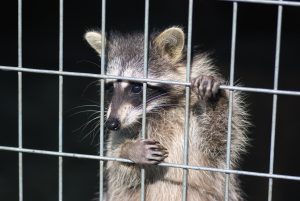Raccoons in the wild, in cities and in rural environments have a shockingly short life span of about 3 years. They can sometimes stretch it to four or five years but generally, they succumb to the elements and die at a young age. This may startle you but raccoons in a lab environment can live for twenty years. They are very long-lived and if not predated or harmed by the weather and run over by cars and shot on farms they would live as long as your pet dog. The same is true for wild dogs in fact. Squirrels as well can live for twenty years in a sterile environment. However, it is important to mention that keeping any native animal in Canada as a pet is illegal. Native animals are protected. You can buy a foreign animal and keep that as a pet. Such things as tigers, alligators and monkeys have been pets, more often than not they end up eating their owners so it’s not something most would recommend.
The raccoon mating season begins in the late winter, around February or March when they start waking from their hibernation. This is when females of at least one year of age or more can begin finding males to mate with. Once she has been impregnated the male will leave to hunt other male raccoons babies as a means of improving his specific genetic line. The female will look for a den that is safe, often an attic is the best place. They will prepare for their childbirth by collecting as much food as they can to feed her new kits. It takes about two months for her to give birth to a litter. Most raccoon litres contain anywhere from one to seven kits. They will be immobile and blind for the first few weeks of growth and will drink their mother’s breast milk for about 4 months after birth and will remain with their mother until they are one year old. This is when they will often leave, males will go find females to mate with and females will repeat the process of mating, finding a den and raising their babies. The only issue is they tend to do it in your attic.

The best way to get the raccoon out, though you will have to get the immobile babies out yourself, is to attach a one-way door to the main entrance the raccoon made to get into your attic. This will involve going on the roof and inspecting for entryways. Seal all the entryways except for the main entryway. Buy a one-way door from home hardware and do not go cheap. Buy the best one you can find and attach it to the main entryway. Get the babies out and into a small box placed near the one-way door and the raccoon will vacate and take her babies off the property. If you would rather try trapping the raccoon yourself and relocating it you can try making a homemade raccoon trap. The process goes like this:
You will need
- A sturdy outdoor garbage can
- A surface that is level with the can, like a table
- A plank of wood
- Bait the raccoon likes, ie: meat
Now you will need to set the trap up
- Place the garbage can at the end of the table and pile rocks or bricks or sandbags around it to keep it from being tipped over, allowing the raccoon to escape.
- Fill the can about a quarter of the way with water, enough that the raccoon will have to swim to keep its head above water but not so much that it could drown.
- Place the plank on the table so it will fall with weight on it and place the bait at the end of the board. Do this at sundown so birds won’t steal the bait.
Check the nest morning to find a wet raccoon ready to be relocated less than one kilometre away by law.

